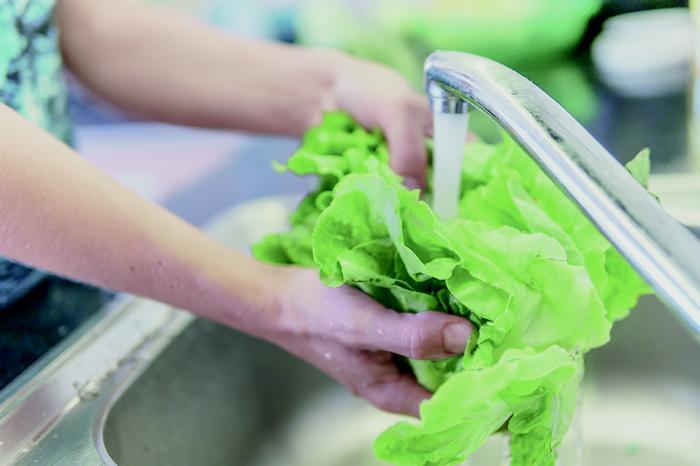12 June 2025
Hide and seek
As fresh produce consumption rises, so too do potential risks. New research in Irish horticulture explores where hidden contamination can occur, and how to stop it before it reaches your plate.

While fresh produce is increasingly a part of healthier diets, it’s important to understand potential sources of contamination from unprocessed food sources. Credit: Efired/shutterstock.com/
Behind every piece of fresh produce is a complex supply chain – and potential risks that aren’t always visible. As concern over foodborne illness grows, researchers are looking beyond the produce itself to what’s happening in the environment where it’s grown.
There are a number of reasons that may have contributed to the increase in disease outbreaks linked to consumption of fresh fruit and vegetables.
Firstly, an increasing emphasis on healthier diets, as well as dietary shifts toward the consumption of more plant-based products, have led to higher fruit and vegetable consumption. These are often consumed raw, or with minimal processing, which increases the risk of exposure to pathogens, if contamination has occurred.
Additionally, the scale and complexity of food production and distribution networks has expanded, facilitating the spread of contamination, if it occurs, across multiple regions.
Elena Anedda, Technologist in the Food Safety Department at Teagasc Ashtown says: “Improvements in detection and trace-back methods such as sequencing – which analyses the genetic makeu-p of pathogens – have greatly improved the ability to identify the source of foodborne disease outbreaks and also identify outbreaks that may have previously gone unnoticed.”
How contamination happens
Listeria monocytogenes, Shiga-toxin producing Escherichia coli (STEC) and Salmonella spp. are foodborne pathogens that have all caused disease outbreaks linked to the consumption of horticultural products, with significant public health implications worldwide.
These pathogens are commonly found in environmental reservoirs like soil, manure, wastewater and wildlife, all of which can act as sources of crop contamination. Transmission can occur in various ways – through contaminated irrigation water, contact with soil, farm equipment, or during harvesting – making the entire production environment a potential risk.
“There is little information about their prevalence or the ecological niches in which they may reside in Irish horticultural production settings,” Elena notes.
“Such information is critical to inform risk management strategies to minimise cross contamination and ensure product safety.”
Working with Irish horticulture
As part of its objectives, the HortAssure project sought to map and identify potential contamination sources and at-risk areas for foodborne pathogens in commercial horticultural environments in Ireland. Production sites for three crops commonly grown in Ireland, each with differing risk profiles, namely carrot, strawberry and lettuce, were selected to evaluate microbial contamination risks.
Environmental swab samples were taken from food-contact and non-food-contact surfaces, together with water and produce samples on a number of occasions. The pathogens of interest, L. monocytogenes, STEC, and Salmonella spp., were tested for using a combination of culture-based and molecular methods.
Hidden risks in the environment
None of the target pathogens were detected in the fresh produce samples tested and Salmonella was not detected in any sample type. L. monocytogenes was detected in 13 samples from different production facilities from a number of surface types, whilst Shiga-toxin genes were detected in eight water samples from different sites. Whole genome sequencing was performed on the pathogen isolates to further characterise the strains and assess their genetic relatedness. A variety of virulence genes were identified in these strains, underscoring their pathogenic potential for humans.
Sequencing… greatly improves identification of outbreaks that may have previously gone unnoticed.
“This genomic analysis was able to provide a more in-depth understanding of how cross contamination may occur within specific facilities and processes, as well as identifying areas that may act as harbourage sites for foodborne pathogens,” explains Elena. “Such environmental mapping of at-risk areas can inform the design of cleaning and sanitation schedules to best effect.”
Additional analysis of the isolated strains demonstrated their ability to form biofilm, a protective layer that can provide enhanced resistance to cleaning and disinfection and contribute to persistence in production settings. These findings emphasise the critical need for stringent hygiene practices and environmental monitoring to mitigate the risk of product contamination.
A path to safer production
Different crop production systems present varying microbial food safety risks, underscoring the importance of comprehensive risk assessments to identify and mitigate potential hazards.
While L. monocytogenes was detected in a number of the environmental samples, it was not found on any produce samples, with its prevalence varying depending on the crop type. Whole genome sequencing provided valuable insights regarding the introduction and persistence of isolates in the production environment, thereby supporting the design of more targeted and effective cleaning and disinfection plans to minimise microbial risks.
The study also demonstrated that environmental monitoring programmes are vital components of effective risk management strategies, contributing to providing assurance of the safety of Irish horticultural produce.
Funding
The HortAssure project was funded by the Department of Agriculture, Food and Marine.
Contributors
Elena Anedda, Technologist, Teagasc Ashtown. elena.anedda@teagasc.ie
Kaye Burgess, Principal Research Officer, Teagasc Ashtown.
Michael Arthur, Walsh Scholar, Teagasc Ashtown.
Michael Gaffney, Principal Research Officer, Teagasc Ashtown.
